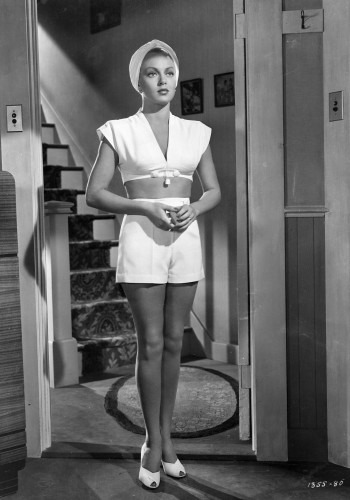
The Male Gaze is essentially where women in the media are introduced and viewed as passive objects to the heterosexual male audience for their own desires. As the film industry is predominantly male dominated and a male-run industry it causes the eruption of assumptions that women are bound to be sexualised regardless.
The concept of the male gaze was first introduced by Laura Mulvey in her now famous 1975 essay called, ‘Visual Pleasure and Narrative Cinema’. Mulvey argues that traditional Hollywood movies respond to a deep seated drive, known as, scopophilia which means a sexual pleasure involved in simply by looking at one, often a female. In other terms, Mulvey introduced the concept of “scopophilia,” which refers to the pleasure derived from looking. In the context of the male gaze, the visual experience is geared toward the male viewer’s pleasure, with women serving as the primary objects to be looked at and consumed visually.
She also wrote that women are characterised by their ‘to-be-lookedatness’ in films and how women are the spectacle and that men are the bearer of the look. Mulvey states that ŌĆ£the gender power asymmetry is a controlling force in cinema and constructed for the pleasure of the male viewer, which is deeply rooted in patriarchal ideologies and discourses.ŌĆØ This means┬Āthat the male viewer is the primary target audience, therefore their needs are met first and that this problem stems from an old fashioned, male-driven society. Her theory on how women are portrayed in film and the media is just as prevalent today as it was in 1975 when her text was first published.
Her theories have helped create a more modern, refined version

The Postman Always Rings Twice (1946) offers a famous example of this claim and representation of the male gaze. The scene, the picture above shows, is the first time the audience are being introduced to this character called Cora Smith. Smith is the the female lead of the film and sexualised in so many different ways in terms of clothing to camera angles. Close-up shots of her in a revealing outfit in which forced the viewer to stare at her in an inappropriate manner, sexualising her heavily; enforcing the idea of the male protagonists point of view of her.
Power dynamics play a huge role in the idea of the male gaze. The male gaze reinforces power imbalances between men and women. Men are positioned as active observers and participants, while women are positioned as passive objects to be observed. The narrative is also another key role in the idea of the male gaze, Mulvey argued that the male gaze contributes to the disruption of the narrative by turning the female character into a spectacle. This objectification often interrupts the flow of the story to emphasize the visual pleasure derived from looking at the female body.
References:
Vanbuskirk.S (2022), ŌĆ£What is the Male Gaze?ŌĆØ, Available at: https://www.verywellmind.com/what-is-the-male-gaze-5118422 , Accessed on: 28thNovember
Devakishen.B (2019),┬ĀŌĆ£Sexism and the male gazeŌĆØ, Available at:┬Āhttps://www.concrete-online.co.uk/sexism-male-gaze/┬Ā, Accessed on: 29thNovember┬Ā
Crawford.M,┬ĀŌĆ£What is the male gaze? Definition, examples & historical importance.ŌĆØ, Available at:┬Āhttps://filmlifestyle.com/what-is-the-male-gaze/┬Ā, Accessed on: 29th┬ĀNovember┬Ā┬Ā┬Ā┬Ā┬Ā┬Ā┬Ā┬Ā┬Ā┬Ā┬Ā┬Ā┬Ā┬Ā┬Ā┬Ā┬Ā┬Ā┬Ā┬Ā┬Ā┬Ā┬Ā┬Ā┬Ā┬Ā┬Ā┬Ā┬Ā┬Ā┬Ā┬Ā┬Ā┬Ā┬Ā┬Ā┬Ā┬Ā┬Ā┬Ā┬Ā┬Ā┬Ā┬Ā┬Ā┬Ā┬Ā┬Ā┬Ā┬Ā┬Ā┬Ā┬Ā┬Ā┬Ā┬Ā┬Ā┬Ā┬Ā┬Ā┬Ā┬Ā┬Ā┬Ā┬Ā┬Ā┬Ā┬Ā┬Ā┬Ā┬Ā┬Ā┬Ā┬Ā┬Ā┬Ā┬Ā┬Ā┬Ā┬Ā┬Ā┬Ā┬Ā┬Ā┬Ā┬Ā┬Ā┬Ā┬Ā┬Ā┬Ā┬Ā┬Ā┬Ā┬Ā┬Ā┬Ā┬Ā┬Ā┬Ā┬Ā┬Ā┬Ā┬Ā┬Ā┬Ā┬Ā┬Ā┬Ā┬Ā┬Ā┬Ā┬Ā┬Ā┬Ā┬Ā┬Ā┬Ā┬Ā┬Ā┬Ā┬Ā┬Ā┬Ā┬Ā┬Ā┬Ā┬Ā┬Ā┬Ā┬Ā┬Ā┬Ā┬Ā┬Ā┬Ā┬Ā┬Ā┬Ā┬Ā┬Ā┬Ā┬Ā┬Ā┬Ā┬Ā┬Ā┬Ā┬Ā┬Ā┬Ā┬Ā┬Ā┬Ā┬Ā┬Ā

I like the beginning of the article to comprehensively explore the male gaze by drawing on Laura Mulvey’s influential 1975 essay. And the example of “The Postman Always Rings Twice,” effectively illustrates the persistence of these problems. However, in order to enhance the persuasiveness of this article, it is suggested that more latest examples or updates can be considered to show the evolutionary perspective of male perspectives in contemporary films. In addition, trying to emphasize the positive challenges of the industry and subversion of these norms can provide a more balanced view for the article. I think the author has done a good job in in-depth study of power dynamics and narrative destruction, which is the key aspect of male gaze on discourse.
Your blog was explanatory, and well-written. You used a very common and famous example in your blog ‘The Postman Always Rings twice’, I think this is a good example because the way they present Cora Smith is in a very much sexualized way even by what she is wearing which automatically attracts the male attention. As they present the female and males differently.I would say to better your blog talk about another example or point used in Mulvey’s book and expand on it.